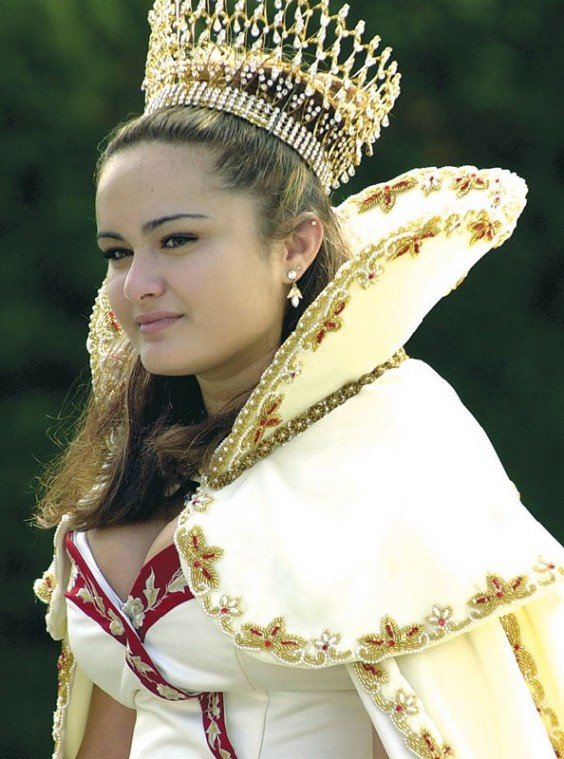Gilroy
– Our Lady of Fatima smiled down upon the Portuguese people of
South Valley this weekend. I saw it happen. I really did.
When I first arrived at Gilroy’s Portuguese Hall on Sunday
morning, a gray overcast lingered in the morning sky. People
gathered in the parking lot, getting ready for the religious
procession from the cultural hall on Old Gilroy Street to St. Mary
Church seven blocks away.
Gilroy – Our Lady of Fatima smiled down upon the Portuguese people of South Valley this weekend. I saw it happen. I really did.
When I first arrived at Gilroy’s Portuguese Hall on Sunday morning, a gray overcast lingered in the morning sky. People gathered in the parking lot, getting ready for the religious procession from the cultural hall on Old Gilroy Street to St. Mary Church seven blocks away. A special Mass would be said there in honor of Our Lady of Fatima. Excited anticipation buzzed the air as I paced through the hall’s parking lot. People in their Sunday best milled around. A brass band tuned musical instruments. A large number of girls, from about 5 to late adolescence, ambled about in elaborately decorated gowns and flowing capes embroidered with costume jewels. Tiaras and crowns rested on their young heads.
Outside the hall’s chapel, I chatted with Cecilia Leonardo, 6, selected this year’s festival queen along with her sister Angela Leonardo, 5. Cecilia waited to have her photo taken by the statue of Our Lady in the chapel.
“That’s a beautiful cape. It’s so long,” I told her, observing how a plastic underskirt protected it from the ground. Cecilia smiled a little shyly.
“Are those real diamonds?” I asked, pointing at her crown.
“No,” she said.
“That would be a little bit expensive,” noted Lucinda Silveira, secretary for the Our Lady of Fatima organization. She had overheard my break-the-ice question. “We’re a small organization. We can’t afford real diamonds.”
Silveira and I laughed and chatted a bit about the royal attire. I found myself instantly warmed by the genuine humanity of the people now gathering for the parade. They came from cities nearby and far away. Some were South Valley residents, arriving from San Benito County, San Martin, Morgan Hill as well as Gilroy, of course. Some Portuguese Halls such as those in Newark, Santa Clara and Visalia also sent representatives.
Waiting next to the door of the chapel for the photographs to be finished, Gilroy contractor Roger Silva, a native of the Azores, enlightened me about the Portuguese culture in South Valley. He and his family left his island home when he was 8 years old. He remembers how in grade school, one teacher made a jest about immigrants who came to America believing the streets were literally paved with gold.
“I didn’t think it was funny,” Silva said. “I told her, ‘The streets are paved with gold. You just don’t recognize it.'”
I saw the pride in Silva’s face as he described how hard the immigrant Portuguese worked to build their lives in their new homes. They saw tremendous opportunity in California. They saw the true gold in the Golden State. But even still, years later in the new land, the bonds to the old country remain strong for Silva and others. That’s why, he said, he feels the desire to preserve the ancient traditions with celebrations such as this festival honoring Our Lady of Fatima.
“It makes me feel a little like I’m still part of what I came from,” he said. “Being Portuguese is very important to me.”
Someone with a squealing microphone started organizing parade participants, herding them into the right order for the procession. While I watched the activity, a man with a neatly cropped beard asked why I was taking notes. He wore jeans and a T-shirt covered by a kitchen apron. He introduced himself as Joe Dutra – “Joe’s a good ol’ Port-ee-gee name,” he boomed. He was helping out in the hall kitchen fixing the sopas for the big afternoon lunch.
Several Portuguese people had already invited me to their festival banquet, but I felt reluctant to take up the offer. But I was curious to find out about the “sopas,” this dish so many people raved about.
Dutra took me into the hall’s kitchen. It steamed with a wonderful broth aroma – the fragrance of Our Lady’s heaven, I imagined. I peered into four 100-gallon kettles boiling away with either beef chunks or quartered cabbage heads. A large kitchen worktable was covered by countless stainless steel bowls filled with a crusty French bread. Dutra explained that just before the sopas was served, the calf and cabbage broth would be poured into each bowl. Then a cook, using a special plunger device, would squeeze all the air out of the bread, letting it sponge up with the delicious soup.
“On Friday, we were here cutting the meat into pieces,” Dutra said. “It’s all family oriented. You got the husbands. You got the wives. Everyone’s doing something.”
Several Portuguese men – the chefs – stood around the kitchen drinking beer and watching a football game on a TV set. They’d earned their rest.
Returning outside, I saw the parade just starting. The Nova Alianca marching band of San Jose began playing a respectful march, and people began to step in somber procession. I wondered if the music might have been written by John Philip Sousa, a famous Portuguese. Band members later told me John Mello Bettencourt of San Jose wrote it.
I followed the procession a short ways along the sidewalk, but then felt silly doing that. Hey, why not just get into the parade, too, I thought. That’s how I came to tag along beside Leianna Jeske and Gianna Jeske, sisters from Gilroy. Their daughters Anyssa Jeske, 8 and Lilianna Jeske, 5, sat with other children on a parade float being pulled by a pick-up.
Each child wore a banner across the chest with a Portuguese name on it. At first, I thought it was each kid’s last name, but Gianna told me each child represented one of the nine volcanic islands of the Azores. The Jeske sisters, I found out as the procession turned onto Eigleberry Street, are not Portuguese but Polish-Italian in ancestry.
“How did your children get involved in the parade then?” I asked.
Turns out their mother’s good friend is Adelia Leonardo, the wife of Tony Leonardo, the festival president. Adelia asked them to participate.
“We grew up with Portuguese friends,” Gianna said, “so we know a lot about them.”
At the front of the float stood a young girl dressed in the white gown and head scarf of Our Lady of Fatima. She firmly held on to a brace board to keep from falling off. She gazed steadily on the marchers – as somber as a statue. As we ambled down Eigleberry Street, festival organizer Maria Rocha told me the story of Our Lady of Fatima.
Our Lady of Fatima
On May 13, 1917, the Virgin Mary appeared to three young children herding sheep near the Portuguese village of Fatima. The 9-year-old girl was Lucia dos Santos, and her cousins were Francisco, 8, and Jancito Marto, 6. Rocha pointed out three youngsters in the parade float wearing traditional peasant garments. They looked adoringly at the girl portraying the Virgin. They represented the children in the miracle, Rocha said. The children told the villagers of Fatima about the apparition, but few believed.
“The kids were even jailed – to frighten them more than to punish them,” Rocha said. “But they always stuck to their story.”
The Virgin promised a miracle to convince the people. So in October of that year, the Virgin made the sun “roll around” in the heavens. The people of Fatima were frightened by this celestial display, but it also convinced them the children indeed had met the Virgin.
I gazed up at Sonia Azevedo, the Gilroy girl who personified Our Lady of Fatima in the procession. At that moment I saw her smile. About 11:30 a.m., the procession reached the main entrance to St. Mary. The participants basked in the sun now breaking through the overcast. For the record, it did not roll around in the sky.
More than a few Portuguese queens, I observed, scrambled across the street to the Jack-in-the-Box restaurant for a quick snack before the two-hour Mass began.
I decided to skip the religious service and see what might be happening at the Portuguese Hall. After a long walk back, I found Dutra leaning against the beverage bar enjoying his beer. “OK, Joe,” I said, remembering how good the broth steam smelled. “Here’s the deal. I’ll stay for lunch, but only if I can help out. You got something for me to do?”
He grinned. “I think we can manage something.”
The kitchen clock showed it was just after 2 p.m. when people started showing up from the Mass. The long rows of tables filled up fast. Someone at long last made the decision to start serving. I tied on a kitchen apron. A frantic but controlled tempo hit the cooking and serving crews. One man poured hot broth over the bread, and another chef pushed a plunger down on the dish, releasing the bubbles. He handed the hot bowl to me.
“You must serve the queens first,” he said.
Carefully, considering it might be bad luck (as well as a major social gaffe) to drop the first sopas, I carried the bowl to the special table reserved for royalty. The children eyed the steaming dish with hungry gazes.
The next hour was spent in a constant rush, bringing food to the guests – sometimes forming bucket brigades with other waiters to make the distribution go faster. My stomach murmured hunger pangs from continuous inhaling of the aroma of the hearty cuisine. But I saw many happy smiles as I brought out the sopas.
At last, it was the waiter’s turn. Tired and sweat-drenched, I sat down to eat. I took my very first mouthful of the steaming-hot sopas and pronounced it, “Excellent!”
Our Lady of Fatima indeed smiled this weekend on the South Valley. It really happened. I saw her smile in the eyes of the Portuguese people I met on Sunday as they shared their extraordinary culture with me.
Obrigado! Thank you.














